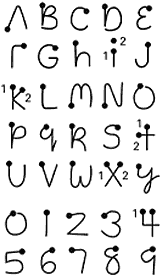
Graffiti 2
Encyclopedia

Palm OS
Palm OS is a mobile operating system initially developed by Palm, Inc., for personal digital assistants in 1996. Palm OS is designed for ease of use with a touchscreen-based graphical user interface. It is provided with a suite of basic applications for personal information management...
handwriting system, Graffiti
Graffiti (Palm OS)
Graffiti is an essentially single-stroke shorthand handwriting recognition system used in PDAs based on the Palm OS. Graffiti was originally written by Palm, Inc...
, that was introduced in 2003. In January of that year PalmSource announced the change, and explained that Graffiti 2 was based on Jot by Communication Intelligence Corporation (CIC), and would replace the original version of Graffiti. Graffiti 2 made its debut in Palm OS 4.1.2 for Motorola DragonBall-based handhelds and Palm OS 5.2 for ARM-based
ARM architecture
ARM is a 32-bit reduced instruction set computer instruction set architecture developed by ARM Holdings. It was named the Advanced RISC Machine, and before that, the Acorn RISC Machine. The ARM architecture is the most widely used 32-bit ISA in numbers produced...
ones.
History
The primary reason for the change was the fact that in April 1997 XeroxXerox
Xerox Corporation is an American multinational document management corporation that produced and sells a range of color and black-and-white printers, multifunction systems, photo copiers, digital production printing presses, and related consulting services and supplies...
had sued PalmSource, Inc. over its use of Graffiti. After a legal fight lasting a number of years, and despite the dismissal of the case by a federal judge, Xerox won a reversal late in 2001 in the U.S. Court of Appeals.
As part of their press for the new handwriting recognition system, PalmSource argued that Jot and Graffiti 2 more closely followed the standard ways of drawing letters and numbers than the original Graffiti did; and they also argued that lowering the learning curve would attract more new users to the platform. But the move alienated many long-time Palm users, who were quite happy with the previous version of Graffiti, which they claimed was much easier to use (though perhaps not to learn).
The most prominent issue involved was the number of stylus
Stylus (computing)
In computing, a stylus is a small pen-shaped instrument that is used to input commands to a computer screen, mobile device or graphics tablet...
strokes required to execute a character. The original Graffiti recognition software required only a single stylus stroke for almost every alphanumeric character. Graffiti 2, however, required the user to execute two strokes in order to create many commonly used characters. This was seen as a lot of extra work, especially considering "i" and "t" were two of the characters affected.

